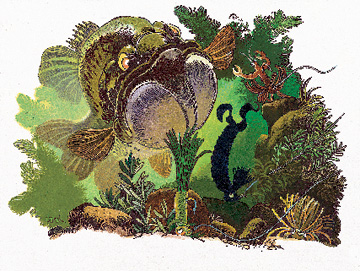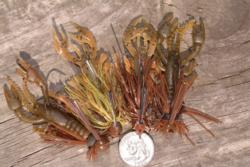Peewee power
The finesse jig is becoming the miniature Hercules of the jig-and-pig family

Jig-and-pig. The lure’s very name sounds boorish and unruly. For years the bait has lived by the creed that “the bigger, the bulkier – the better.” The hulking mass of lead, rubber and pigskin has long been heralded as a tournament-winning bait.
Over the last several years, however, the jig-and-pig has gone on a diet, so to speak. Along the Wal-Mart FLW Tour and the EverStart Series, more pros have started fishing a slimmed-down version of the jig-and-pig called a “finesse jig.”
How can bass fishing’s biggest, baddest lure even be in the same sentence with the word “finesse”? It sounds as promising as a flimsy flipping stick.
But don’t knock these dainty crawfish imitators. The bulk has been taken out, but not the muscle. These petite jigs still have plenty of power.
Lure companies are well aware of this peewee power, too. The Eakins Jig, PJ’s Jigs, the Terminator Tiny-T, PRADCO’s Booyah Boo Bug and Lunker Lure’s Body Lok Junior are just a few examples of finesse jigs currently on the market.
This tackle trend is actually old hat in the Midwest, where veteran bassing experts have used finesse jigs for decades. Such longtime finesse jiggers include Mike Wurm of Hot Springs, Ark., and Jim Eakins of Nixa, Mo.
Both of these professional anglers have proven that peanut-sized jigs catch more than just peanut-sized bass.
In 1999, Wurm won a snow-blown FLW Tour stop on South Carolina’s Lake Murray by crawling a finesse jig through brush piles for lethargic bass.
Tournament anglers who compete in the Midwest know about Jim Eakins and his son, Troy, who made a living on tiny finesse jigs during the mid-1990s. At the time, Jim poured and tied his own jigs and kept his diminutive creations a well-guarded secret. Since then he has teamed up with Jewel Bait to commercially produce his Eakins Finesse Jig.
In 2003, Troy fished his father’s jig to three different fourth-place finishes in the Central Division of the EverStart Series.
Pro Eric Holt of Galena, Mo., is an Eakins Jig fanatic as well. He has used the jig to garner three FLW Tour top-10s, including a second-place finish at the FLW Tour Championship on Fort Gibson in 1999.
Finesse jigs are readily identifiable by their compact size. While the conventional jig-and-pig is 4 to 5 inches long, a finesse jig usually measures only 2 1/2 to 3 inches.
Finesse jigs get their petite appearance from tiny skirts – mere miniskirts when compared to the full-sized dresses worn by their larger cousins. Some of the skirts, like those found on Eakins Finesse Jigs, are only half skirts, with the other half cut down to the skirt collar to make a “tickle-head” or “fuzz-head,” as some call it.
Most companies making finesse jigs produce two models: a regular finesse model and a flipping model. Regular finesse jigs are usually 1/8-ounce to 5/16-ounce in size and molded with a light wire hook. Flipping versions are heavier – 7/16- to 1/2-ounce in size – and have a much heavier gauge hook for powerful hooksets.
Where and how to finesse-jig
Wurm was a finesse-jig expert long before he won the 1999 FLW Tour stop on Lake Murray. In fact, he also sold finesse jigs commercially during the 1980s under the name Wurm’s Round-Head Jigs. He carries finesse jigs around the country on the pro tours and knows that finesse jigs are not relegated to the clear, rocky waters of the Midwest.
“Lake Murray, Potomac River, Logan Martin, Wheeler, Toledo Bend, Kentucky Lake – I’ve used it everywhere, especially when the bite is tough,” he said.
Holt shares Wurm’s opinion on the versatility of finesse jigs.
“When the Eakins Finesse Jig first came out, a lot of people thought it was primarily a spotted bass or smallmouth lure for the Midwest,” he said. “That’s not the case; it catches a lot of largemouths, too, and it can be used all over the country.”
Jim Eakins uses his namesake 5/16-ounce finesse jig everywhere in all seasons because it so closely imitates one of the bass’s most ubiquitous prey.
“The jig is designed to imitate a crawfish,” he said. “Crawfish are present in most lakes all year long. The Eakins Jig has made jig fishermen out of a lot of people because it’s so easy to fish. At sport shows, I have people come up and thank me for putting it on the market. They claim it taught them how to jig-fish.”
Holt also appreciates the jig’s simplicity.
“I don’t do anything really fancy with it,” Holt said. “I usually cast it or pitch it all the way to the bank and just crawl it or hop it back to the boat.”
He likes the jig best on rocky lakes with a lot of fishing pressure.
“One of my favorite times to fish it is the spring of the year, when I’m targeting rock transitions where chunk rock turns to pea gravel in the back of spawning coves,” he said.
Wurm enjoys fishing a finesse jig around dock pilings and brush piles.
“It will come through brush fine, but you can’t get in a hurry with it,” he said. “It’s a bait that’s designed to be fished slow and easy.”
Finesse-jig equipment
Fishing the finesse jig on proper equipment is important in order to feel what the bait is doing at all times. In general, the jig requires lighter line and softer rods.
Wurm almost exclusively uses spinning tackle. He prefers a 7-foot spinning rod in a medium-heavy action.
“Spinning tackle gives me more control of the bait around docks,” he said. “I can skip it, control it and feel it better with a spinning rod. I use either 8- or 10-pound-test Vanish fluorocarbon line, which helps with the feel tremendously.”
Both Holt and Eakins use a casting rod designed by Eakins and manufactured by Falcon Rods called the Eakins Jig Rod.
“It’s a 6-foot-10-inch medium-heavy action casting rod that I designed specifically for my jig,” Eakins said.
Like Wurm, both Holt and Eakins prefer fluorocarbon line in the 8- to 12-pound-test range for its sensitivity and no-stretch properties.
“I look at finesse-jig fishing as a complete system,” Eakins said. “The critical parts are a good jig, sensitive line and the proper-action rod.”
When it comes to hooking and playing fish on small jigs and light tackle, Wurm insists that anglers cannot be in a hurry.
“First of all, you don’t need a great big, explosive hookset with these little bugs,” he said. “When you get a bite, just lean back into the fish and start reeling. Once you get a fish on, especially a big one, don’t horse them. Take your time and play them out.”
Trailers, modifications and colors
Matching the right trailer with a finesse jig is critical to keep from ruining the jig’s compact appeal.
Some finesse-jig manufacturers make their own plastic craws designed to match their jigs. Such is the case with the Eakins Craw. Other trailer considerations for finesse jigs include Zoom’s Critter Craw or Zoom’s assortment of small plastic “Junior” chunks.
Another easy consideration for finesse jigs is color. All three of these finesse-jigging experts say that basic brown and green pumpkin combinations account for most of their fish. Occasionally a black and blue or brown and orange are possible choices, but for the most part, there is no need to stray beyond a brownish/green skirt with a green pumpkin trailer.
In terms of modifications, Holt likes to trim the weedguard on the Eakins Jig.
“Most of the time I’ll cut more than half of the bristles off, especially in open water,” he said.
Still not convinced that the miniature Hercules of the jig world can improve your fishing? Keep your eyes peeled on the FLW Tour and EverStart Series this year to see if more pros don’t start scaling back with peewee power.
